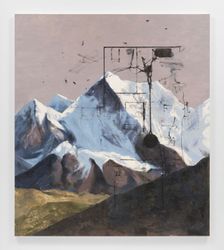For his first New York solo exhibition with Hauser & Wirth, the internationally celebrated Argentina-based artist Guillermo Kuitca will present a group of new paintings that reveal his diverse interests and aesthetic approaches. Pintura sin muros ('Painting without walls') showcases the evolution of Kuitca's use of floorplans, maps and bedrooms, as well as cubistoid structures to visually fragment the surfaces of his paintings. Here, for the first time in his five-decade career, Kuitca will also present landscapes—vistas of mountains, seas and plains are layered beneath architectural blueprints that serve as tools in the artist's ongoing effort to describe the experience of interior psychological spaces for both containment and expansive exploration.
Pintura sin muros has been curated by Tobias Ostrander, independent curator working in Mexico City and London, and former chief curator of the Pérez Art Museum Miami.
The exhibition's paintings vary in scale and orientation, shifting dramatically from large vertical canvases to more intimate horizontal works. This physical variety coincides with and echoes the diversity of Kuitca's subject matter, a hallmark of his artistic practice and all the more remarkable here: Kuitca, who typically works in series and focuses upon one visual theme at a time, completed all the works on view in a single year in a burst of inspiration and intensity.
Landscape is a subject the artist's practice has not previously addressed. In 'Pintura sin muros' it plays a prominent role with paintings that reference an array of geographies, from snow-covered mountains to fields of brown and green. Several of these works depict waves dashing a rocky coast, with the ocean's distant horizon bisecting each composition. Kuitca's landscapes recall areas of his native Argentina, specifically the Andes Mountains, the fertile fields of the Pampas and the coast of nearby Uruguay. Such direct references to his homeland are unprecedented within the artist's output; but consistent with previous subjects in his oeuvre, Kuitca's landscapes incorporate provocative superimpositions—house plans layered onto or disintegrating into natural vistas—to represent the dissolving of interior and exterior spaces into a unified, existential whole.
A recurring element in Kuitca's cubistoid spatial articulations, house plans nod to the modernist forms developed by such 20th Century artists as Pablo Picasso and Georges Braque. Kuitca first introduced these cubistoid explorations in 2007, in a suite of paintings presented at that year's Venice Biennale, where he represented Argentina. A completely unexpected quotation from art history at that moment, his formal engagement with the legacy of Cubism, as well as such luminaries as Lucio Fontana, has evolved into a central element of his practice.
Some of these latest paintings on view in the exhibition eschew the device of house plans altogether, and instead evoke the roads and mountain ranges that one would typically find on a map. Like house plans, maps represent a codified visual language—a standardized form of visual communication—that the artist can manipulate into a lyrical abstraction.
Additionally, bedrooms and beds have played a significant role within Kuitca's work. Signaling the universal yet endlessly unique human experiences of sleep, sex, death and dreams, they have appeared consistently in his paintings since 1982. In Pintura sin muros, they reappear, most often in the form of single beds. Taking on prominent roles within several of the paintings on view, they are typically surrounded and accentuated by a disordered assortment of other furniture. Only one work in the exhibition contains a human figure; in this case, a bed containing a sleeping figure. Solitary within a cavernous space, Kuitca's sleeper is surrounded by ghoulish shades rendered in gentle grays, pinks and purples—an image that recalls Francisco Goya's haunting etching, The Sleep of Reason Produces Monsters (1797). Like so many of Kuitca's paintings of domestic, interior structures, this work is charged with psychological experience and evocations of subconscious ripples, subjects that course through the artist's work and endow it with its unique, ineffable power.
Hauser & Wirth extends a special thank you to Angela Westwater, Sperone Westwater for their ongoing collaboration.
Press release courtesy Hauser & Wirth.
542 West 22nd Street
New York, 10011
United States
hauserwirth.com
+1 212 790 3900
Tuesday – Saturday
10am – 6pm
